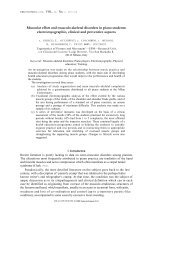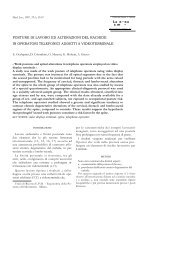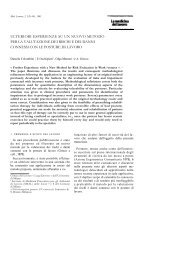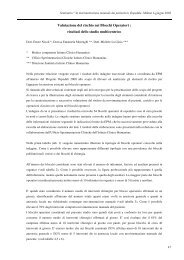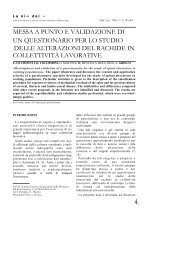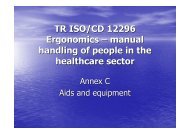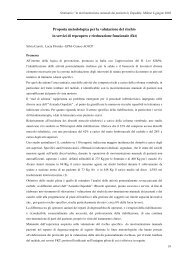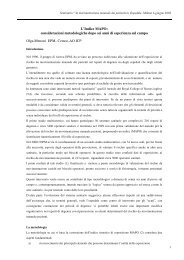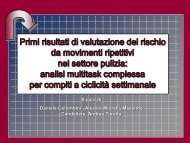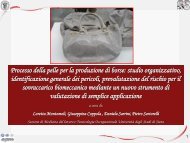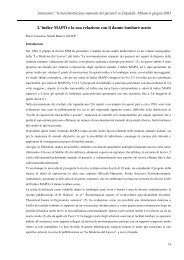Ocra method a new procedure for analysing multiple repetitive tasks
Ocra method: a new procedure for analysing multiple ... - epm
Ocra method: a new procedure for analysing multiple ... - epm
Create successful ePaper yourself
Turn your PDF publications into a flip-book with our unique Google optimized e-Paper software.
proposed <strong>for</strong> a <strong>new</strong> ISO TR “Application document <strong>for</strong> ISO11228- part 1,2 and 3 and <strong>for</strong> ISO 11226”METHODS: ORGANIZATIONAL DATAGeneral aspects <strong>for</strong> assessment of exposure levels to workscharacterized by multi-task turnoverWhen dealing with an exposure risk assessment (from upperlimb biomechanical overload) to multitask works, it isnecessary to go through 3 operating stages:- facing a preliminary organizational study to establish thekind of turnover: the periodicity of the different <strong>tasks</strong>(implemented by the worker or by the homogeneous group ofworkers employed in the same <strong>tasks</strong> in the considered period)repeated in time, daily or weekly or monthly or yearly.- defining the risk level inherent in each task, using theOCRA checklist. Intrinsic level means ascribing to the task anet duration of 440 minutes/shift with 2 breaks, 8-10 minuteseach, and a lunch break of at least 30 minutes.- applying specific mathematical models assessing exposureto “multi<strong>tasks</strong>”.As to calculation <strong>procedure</strong>s, the 3 stages will be tackled:first the daily, secondly yearly cycle multi<strong>tasks</strong> and later theweekly cycles.Cyclical turnover and organizational studies on exposureto daily rotating <strong>multiple</strong> <strong>tasks</strong>.This kind of turn-over is typical in the industry and easy toidentify: every day is similar to other.When the <strong>repetitive</strong> task turn-over is daily, 2 events mayoccur:- rotation occurs at least every hour:- rotation occurs less than once per hour.It is not so difficult to obtain accurate exposure data aboutthe net duration (in minutes) of each <strong>repetitive</strong> task in a shift.With these data the proportional distribution among <strong>tasks</strong>over the shift can be obtained being derived <strong>for</strong> each task as a% on the total of hours worked in the shift.The obtained percentages outline the intrinsic timedistribution present among developed <strong>tasks</strong>. The <strong>method</strong>sreported in previous papers (Occhipinti et al., 2008; Colombiniet al., 2008), and summarized (<strong>for</strong> the OCRA checklist) later,could be applied.Cyclical turnover and organizational studies on exposureto yearly rotating <strong>multiple</strong> <strong>tasks</strong>.While in the industry turnover periodicity is typically daily,in other productive sectors this periodicity is longer: <strong>for</strong>example in agriculture it is typically yearly. Each month of theyear is characterized by different processing, each includingdifferent <strong>tasks</strong>. Priority objective to this organizational studystage is identification of workers’ homogeneous groupcarrying out the same <strong>tasks</strong> over the year: which and howmany workers are involved and which <strong>tasks</strong> they carry out.Two solutions are proposed <strong>for</strong> studying the exposureduration to developed <strong>tasks</strong>: (a) a semi-qualitative option,which is simpler, when only few in<strong>for</strong>mation are available(e.g. from worker(s)’ interviews) and (b) the quantitativeoption based on knowledge of hours actually worked in themonth per each task.(a) Simplified organizational study (SEMI-QUALITATIVEMODEL)Table 1 shows a preliminary example of simpleidentification of the different <strong>tasks</strong> carried out by the sameworkers’ group (homogeneous group by job) over one year.It preliminarily reports:- the name of the different <strong>tasks</strong> carried-out in the year (A,B, C,…)- the number of days actually worked in the month- the task(s) carried out in that month (marked by 1)WORKING TASKSQUALITATIVE DESCRIPTION OF WORKED MONTHS / YEARJANFEBMARAPRMAYDAYS WORKED /MONTH 20 20 20 20 25 20 23 0 25 13 25 0 210,00A 1 1 1B 1 1 1C 1D 1E 1 1F 1 1G 1JUNELJULYAUGU2SEPTOCTNOVDECACTUALLY WORKED DAYS / YEARTable 1 - Example of simplified (semi-qualitative) description of the different <strong>tasks</strong> carried out by a homogenous group ofworkers over one year.These simple data already provide useful in<strong>for</strong>mationthrough calculation of percentage using exposure constants.These constants are: 20 days of work a month over 11 monthsa year.The first calibration <strong>procedure</strong>, through time constants, iscarried out to calculate in percentage the exposure days permonth:when the percentage exceeds 100, it means that the worker thatmonth has worked more than 20 days.This first percentage ascribes a semi-qualitative durationvalue to the <strong>tasks</strong> developed in the month and above markedby 1 (Table 1). In the example reported in Table 2, if in onemonth two <strong>tasks</strong> are carried out (see February with a 100%value: he/she has worked <strong>for</strong> 20 days), each task is ascribed




